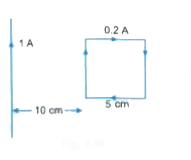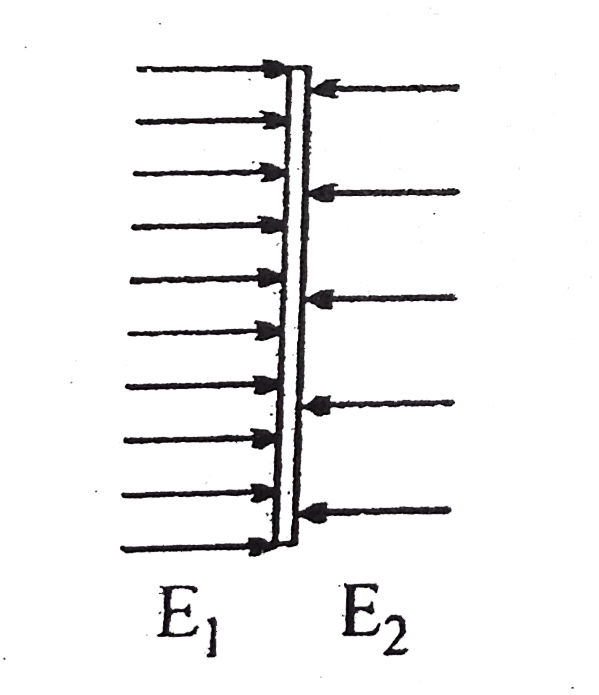A man fixes outside his house one evening a two metre high insulating slab carrying on its top a large aluminium sheet of area 1m2. Will he get an electric shock if he touches the metal sheet next morning?
Yes, the steady discharging current in the atmosphere charges up the aluminium sheet gradually and raises its voltage to an extent depending on the capacitance of the capacitor (formed by the sheet, slab and the ground). As a result, the man will get a shock.
Topper's Solved these Questions
- ELECTROSTATIC POTENTIAL AND CAPACITANCE BOOK - U-LIKE SERIESCHAPTER - ELECTROSTATIC POTENTIAL AND CAPACITANCE EXERCISE - CASE BASED/SOURCE-BASED INTEGRATED QUESTIONS
18 Videos
- ELECTROSTATIC POTENTIAL AND CAPACITANCE BOOK - U-LIKE SERIESCHAPTER - ELECTROSTATIC POTENTIAL AND CAPACITANCE EXERCISE - MULTIPLE CHOICE QUESTIONS
35 Videos
- ELECTROSTATIC POTENTIAL AND CAPACITANCE BOOK - U-LIKE SERIESCHAPTER - ELECTROSTATIC POTENTIAL AND CAPACITANCE EXERCISE - SELF ASSESSMENT TEST
1 Video
- ELECTROMAGNETICE INDUCTIONBOOK - U-LIKE SERIESCHAPTER - ELECTROMAGNETICE INDUCTIONEXERCISE - Self Assessment Test Section -D
1 Video
- EXAMINATION PAPER 2020 (SOLVED)BOOK - U-LIKE SERIESCHAPTER - EXAMINATION PAPER 2020 (SOLVED)EXERCISE - SECTION D
6 Videos
Similar Questions
On the basis of your understanding of the following paragraph and the related studied concepts.
An electric dipole is a pair of equal and opposite point charges q and -9 separated by a distance '2a'. The total charge of the electric dipole is obviously zero but the field of the electric dipole at a point is non-zero because electric fields due to + qand - q charges at the point do not exactly cancel out. Electric field of a dipole, at large distances, depends on the product 'qa'. So we define a term dipole moment vector →p of an electric dipole as →p=q(2a) and its direction is along the line from q to + q charge. The dipole field at large distances fall off as 1r3. Further, the magnitude and direction of the dipole field depends not only on the distance r but also on the angle between the position vector →r and the dipole moment →p.
Concept of electric dipoles is very significant for different materials. In most molecules, the centres of positive charges and of negative charges exactly coincide and their dipole moment is zero. However they develop a dipole moment when an electric field as applied. Such molecules are termed non-polar molecules. But in some molecules, the centres of positive charges do not exactly coincide with that of negative charges and the molecules has a permanent dipole moment even in the absence of an electric field. Such molecules are called polar molecules. Various materials give rise to interesting properties and important applications in the presence or absence of electric field.
Is the electric field due to a charge configuration with total charge zero necessarily zero ? Give an illustration in support of your answer.
View SolutionA hollow metallic sphere of radius 5 cm is charged so that the potential on its surface is 10 V. Thepotential at the centre of the sphere is
View SolutionThree capacitors of a capacitances 3μF,9μF and 18μF are connected initially in series and subsequently in parallel . The ratio of equivalent capacitance in the two cases (CsCp) will be
View Solution(a) Derive the expression for the magnetic energy stored in an inductor when a current I develops in it. Hence, obtain the expression for the magnetic energy density.
(b) A square loop of sides 5 cm carrying a current of 0.2 A in the clockwise direction is placed at a distance of 10 cm from an infinitely long wire carrying a current of 1 A as shown in Fig. 6.66. Calculate (i) the resultant magnetic force, and (ii) the torque, if any, acting on the loop.

View Solution(a) An electric dipole of dipole moment →p is placed in a uniform electric field →E at an angle θ with it. Derive the expression for torque (→τ) acting on it. Find the orientation of the dipole relative to the electric field for which torque on it is (i) maximum, and (ii) half of maximum.
(b) Two point charges q1=+1μC and q2=+4μC are placed 2 m apart in air. At what distance from q1 along the line joining the two charges, will the net electric field be zero ?
View SolutionAnswer the following : (a) The top fo the atmosphere is at about 400 kv with respect to the surface of earth, the field is about 100 Vm^(-1) . Why then do we not get an electric shock, as we step out of out house into the open ? (Assume the house to be a steel cage so that there is no field inside). (b) A man fixes outside his house one evening a two meter high insulating slab carrying on its top, a large aluminium sheet of area 1 m^(2) . Will he get an electric shock if he touches the metal sheet next morning ? (c) The discharging current in the atmosphere due to the small conducity of air is known to be 1800 A on an average over the globe. Why then does the atomsphere not discharge itself complety in due course and become electrically neutral ? In other words, what keeps the atmosphere charged ? (d) What are teh forms of energy into which the electrical energy fo the atmosphere is dissipated during a lighting ?
View SolutionA charged large metal sheet is placed into uniform electric field, perpendicularly to the electric field lines. After placing the sheet into the field, the electric field on the left side of the sheet is E1=5×105V/m and on the right it is E2=3×105V/m. The sheet experiences a net electric force of 0.08N. Find the area of one face of the sheet. Assume external field to remain constant after introducing the large sheet. Use(14πɛ0)=9×109Nm2/C2

View SolutionA large metal sheet carries an electric current along its surface. Current per unit length is lambda . Magnetic field near the metal sheet is.
View SolutionTwo large parallel plane sheets have uniform charge densities + sigma and -sigma. Determine the electric field (i) between the sheets, and (ii) outside the sheets.
View Solutionएक व्यक्ति शाम के समय अपने घर के बाहर 2 मी ऊँचा अवरोधी पट्ट रखता है जिसके शिखर पर एक 1मी 2 क्षेत्रफल की बढ़ी ऐल्युमिनियम की चादर है | अगली सुबह वह यदि धातु की चादर को छूटा है ,तो क्या उसे विद्युत आघात लगेगा ?
View Solutionराकेश अपने घर के बाहर एक कुचालक छज्जे को ऐल्यूनिमियम की शीट से संपर्क करता है , तो उसे विद्युत का झटका लगता है जिससे वह भयभीत हो जता है | जब वह इसकी चर्चा अपने बड़े भाई जो भौतिकी पर प्राध्यापक है , से करता है तो वे इसके कारण की व्याख्या करते है |
उपरोक्त अनुच्छेद को पढ़कर उत्तर दीजिए -
(i) राकेश द्वारा किन मूल्यों की अभिव्यक्ति होती है ?
View Solutionराकेश अपने घर के बाहर एक कुचालक छज्जे को ऐल्यूनिमियम की शीट से संपर्क करता है , तो उसे विद्युत का झटका लगता है जिससे वह भयभीत हो जता है | जब वह इसकी चर्चा अपने बड़े भाई जो भौतिकी पर प्राध्यापक है , से करता है तो वे इसके कारण की व्याख्या करते है |
उपरोक्त अनुच्छेद को पढ़कर उत्तर दीजिए -
(ii) ऐल्युमिनियम शीट से विद्युत का झटका क्यों लगता है ?
View SolutionA man fixes outside his house on evening on its top a large aluminium sheet of area lm2. Will he get an electric shock if he touches the metal sheet next morning ?
View SolutionOne evening a man fixes a two metre high insulating slab carrying on its top a large aluminimum sheet of area 1 m^2 outside his house. Will he get an electric shock if he touches the metal sheet next morning?
View SolutionA man fixes outside his house one evening a 2m high insulating slab carrying on its top a large aluminium sheet of area 1 m^(2) . Will he get an electric shock, if he touches the metal sheet next morning?
View Solution

